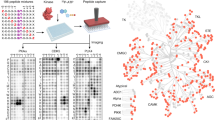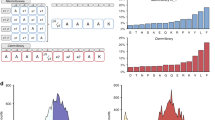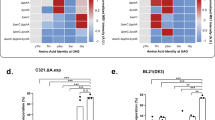Abstract
Protein serine-threonine kinase casein kinase II (CK2) is involved in a myriad of cellular processes including cell growth and proliferation through its phosphorylation of hundreds of substrates, yet how CK2 function is regulated is poorly understood. Here we report that the CK2 catalytic subunit CK2α is modified by O-linked β-N-acetyl-glucosamine (O-GlcNAc) on Ser347, proximal to a cyclin-dependent kinase phosphorylation site (Thr344). We use protein semisynthesis to show that phosphorylation of Thr344 increases the cellular stability of CK2α by strengthening its interaction with Pin1, whereas glycosylation of Ser347 seems to be antagonistic to Thr344 phosphorylation and permissive to proteasomal degradation. By performing kinase assays with site-specifically phospho- and glyco-modified CK2α in combination with CK2β and Pin1 binding partners on human protein microarrays, we show that the kinase substrate selectivity of CK2 is modulated by these specific post-translational modifications. This study suggests how a promiscuous protein kinase can be regulated at multiple levels to achieve particular biological outputs.
This is a preview of subscription content, access via your institution
Access options
Subscribe to this journal
Receive 12 print issues and online access
$259.00 per year
only $21.58 per issue
Buy this article
- Purchase on Springer Link
- Instant access to full article PDF
Prices may be subject to local taxes which are calculated during checkout





Similar content being viewed by others
Accession codes
References
Pagano, M.A., Cesaro, L., Meggio, F. & Pinna, L.A. Protein kinase CK2: a newcomer in the 'druggable kinome'. Biochem. Soc. Trans. 34, 1303–1306 (2006).
Pinna, L.A. Protein kinase CK2: a challenge to canons. J. Cell Sci. 115, 3873–3878 (2002).
Salvi, M., Sarno, S., Cesaro, L., Nakamura, H. & Pinna, L.A. Extraordinary pleiotropy of protein kinase CK2 revealed by weblogo phosphoproteome analysis. Biochim. Biophys. Acta 1793, 847–859 (2009).
Niefind, K., Guerra, B., Ermakowa, I. & Issinger, O.G. Crystal structure of human protein kinase CK2: insights into basic properties of the CK2 holoenzyme. EMBO J. 20, 5320–5331 (2001).
Sarno, S. et al. Cooperative modulation of protein kinase CK2 by separate domains of its regulatory beta-subunit. Biochemistry 39, 12324–12329 (2000).
Meggio, F., Boldyreff, B., Marin, O., Pinna, L.A. & Issinger, O.G. Role of the beta subunit of casein kinase-2 on the stability and specificity of the recombinant reconstituted holoenzyme. Eur. J. Biochem. 204, 293–297 (1992).
Marin, O., Meggio, F., Boldyreff, B., Issinger, O.G. & Pinna, L.A. Dissection of the dual function of the beta-subunit of protein kinase CK2 ('casein kinase-2'): a synthetic peptide reproducing the carboxyl-terminal domain mimicks the positive but not the negative effects of the whole protein. FEBS Lett. 363, 111–114 (1995).
Litchfield, D.W., Luscher, B., Lozeman, F.J., Eisenman, R.N. & Krebs, E.G. Phosphorylation of casein kinase II by p34cdc2 in vitro and at mitosis. J. Biol. Chem. 267, 13943–13951 (1992).
Bosc, D.G., Slominski, E., Sichler, C. & Litchfield, D.W. Phosphorylation of casein kinase II by p34cdc2. Identification of phosphorylation sites using phosphorylation site mutants in vitro. J. Biol. Chem. 270, 25872–25878 (1995).
Hart, G.W., Housley, M.P. & Slawson, C. Cycling of O-linked β-N-acetylglucosamine on nucleocytoplasmic proteins. Nature 446, 1017–1022 (2007).
Lazarus, M.B., Nam, Y., Jiang, J., Sliz, P. & Walker, S. Structure of human O-GlcNAc transferase and its complex with a peptide substrate. Nature 469, 564–567 (2011).
Luo, B. et al. Chronic hexosamine flux stimulates fatty acid oxidation by activating AMP-activated protein kinase in adipocytes. J. Biol. Chem. 282, 7172–7180 (2007).
Zeidan, Q. & Hart, G.W. The intersections between O-GlcNAcylation and phosphorylation: implications for multiple signaling pathways. J. Cell Sci. 123, 13–22 (2010).
Lubas, W.A. & Hanover, J.A. Functional expression of O-linked GlcNAc transferase. Domain structure and substrate specificity. J. Biol. Chem. 275, 10983–10988 (2000).
Vila-Perelló, M. & Muir, T.W. Biological applications of protein splicing. Cell 143, 191–200 (2010).
Muir, T.W., Sondhi, D. & Cole, P.A. Expressed protein ligation: a general method for protein engineering. Proc. Natl. Acad. Sci. USA 95, 6705–6710 (1998).
Piontek, C. et al. Semisynthesis of a homogeneous glycoprotein enzyme: ribonuclease C: part 1. Angew. Chem. Int. Edn Engl. 48, 1936–1940 (2009).
Zheng, W. et al. Cellular stability of serotonin N-acetyltransferase conferred by phosphonodifluoromethylene alanine (Pfa) substitution for Ser-205. J. Biol. Chem. 280, 10462–10467 (2005).
Ohnishi, Y., Ichikawa, M. & Ichikawa, Y. Facile synthesis of N-Fmoc-serine-S-GlcNAc: a potential molecular probe for the functional study of O-GlcNAc. Bioorg. Med. Chem. Lett. 10, 1289–1291 (2000).
Marin, O., Meggio, F. & Pinna, L.A. Design and synthesis of two new peptide substrates for the specific and sensitive monitoring of casein kinases-1 and -2. Biochem. Biophys. Res. Commun. 198, 898–905 (1994).
Liu, Q., Huang, S.S. & Huang, J.S. Kinase activity of the type V transforming growth factor beta receptor. J. Biol. Chem. 269, 9221–9226 (1994).
Loizou, J.I. et al. The protein kinase CK2 facilitates repair of chromosomal DNA single-strand breaks. Cell 117, 17–28 (2004).
Tiganis, T., House, C.M. & Kemp, B.E. Protein kinase CK2: biphasic kinetics with peptide substrates. Arch. Biochem. Biophys. 325, 289–294 (1996).
Sarno, S. et al. Mutational analysis of residues implicated in the interaction between protein kinase CK2 and peptide substrates. Biochemistry 36, 11717–11724 (1997).
Salvi, M. et al. Discrimination between the activity of protein kinase CK2 holoenzyme and its catalytic subunits. FEBS Lett. 580, 3948–3952 (2006).
Sarno, S., Marin, O., Ghisellini, P., Meggio, F. & Pinna, L.A. Biochemical evidence that the N-terminal segments of the alpha subunit and the beta subunit play interchangeable roles in the activation of protein kinase CK2. FEBS Lett. 441, 29–33 (1998).
Homma, M.K. & Homma, Y. Cell cycle and activation of CK2. Mol. Cell. Biochem. 316, 49–55 (2008).
Macauley, M.S., Stubbs, K.A. & Vocadlo, D.J. O-GlcNAcase catalyzes cleavage of thioglycosides without general acid catalysis. J. Am. Chem. Soc. 127, 17202–17203 (2005).
Senderowicz, A.M. Flavopiridol: the first cyclin-dependent kinase inhibitor in human clinical trials. Invest. New Drugs 17, 313–320 (1999).
Gussio, R. et al. Structure-based design modifications of the paullone molecular scaffold for cyclin-dependent kinase inhibition. Anticancer Drug Des. 15, 53–66 (2000).
Shapiro, G.I., Koestner, D.A., Matranga, C.B. & Rollins, B.J. Flavopiridol induces cell cycle arrest and p53-independent apoptosis in non-small cell lung cancer cell lines. Clin. Cancer Res. 5, 2925–2938 (1999).
Fischer, P.M. & Lane, D.P. Inhibitors of cyclin-dependent kinases as anti-cancer therapeutics. Curr. Med. Chem. 7, 1213–1245 (2000).
Bosc, D.G., Luscher, B. & Litchfield, D.W. Expression and regulation of protein kinase CK2 during the cell cycle. Mol. Cell. Biochem. 191, 213–222 (1999).
Messenger, M.M. et al. Interactions between protein kinase CK2 and Pin1. Evidence for phosphorylation-dependent interactions. J. Biol. Chem. 277, 23054–23064 (2002).
Ranganathan, R., Lu, K.P., Hunter, T. & Noel, J.P. Structural and functional analysis of the mitotic rotamase Pin1 suggests substrate recognition is phosphorylation dependent. Cell 89, 875–886 (1997).
Shen, M., Stukenberg, P.T., Kirschner, M.W. & Lu, K.P. The essential mitotic peptidyl-prolyl isomerase Pin1 binds and regulates mitosis-specific phosphoproteins. Genes Dev. 12, 706–720 (1998).
Yuzwa, S.A. et al. A potent mechanism-inspired O-GlcNAcase inhibitor that blocks phosphorylation of tau in vivo. Nat. Chem. Biol. 4, 483–490 (2008).
Hu, S. et al. Profiling the human protein-DNA interactome reveals ERK2 as a transcriptional repressor of interferon signaling. Cell 139, 610–622 (2009).
Meggio, F. & Pinna, L.A. One-thousand-and-one substrates of protein kinase CK2? FASEB J. 17, 349–368 (2003).
Moretto-Zita, M. et al. Phosphorylation stabilizes Nanog by promoting its interaction with Pin1. Proc. Natl. Acad. Sci. USA 107, 13312–13317 (2010).
Zhou, W. et al. Pin1 catalyzes conformational changes of Thr-187 in p27Kip1 and mediates its stability through a polyubiquitination process. J. Biol. Chem. 284, 23980–23988 (2009).
Siepe, D. & Jentsch, S. Prolyl isomerase Pin1 acts as a switch to control the degree of substrate ubiquitylation. Nat. Cell Biol. 11, 967–972 (2009).
Mahoney, S.J., Dempsey, J.M. & Blenis, J. Cell signaling in protein synthesis ribosome biogenesis and translation initiation and elongation. Prog. Mol. Biol. Transl. Sci. 90, 53–107 (2009).
Canton, D.A. & Litchfield, D.W. The shape of things to come: an emerging role for protein kinase CK2 in the regulation of cell morphology and the cytoskeleton. Cell Signal 18, 267–275 (2006).
Cory, G.O., Cramer, R., Blanchoin, L. & Ridley, A.J. Phosphorylation of the WASP-VCA domain increases its affinity for the Arp2/3 complex and enhances actin polymerization by WASP. Mol. Cell 11, 1229–1239 (2003).
Shen, H.H., Huang, A.M., Hoheisel, J. & Tsai, S.F. Identification and characterization of a SET/NAP protein encoded by a brain-specific gene, MB20. Genomics 71, 21–33 (2001).
Choudhary, C. & Mann, M. Decoding signalling networks by mass spectrometry-based proteomics. Nat. Rev. Mol. Cell Biol. 11, 427–439 (2010).
Qiao, Y., Molina, H., Pandey, A., Zhang, J. & Cole, P.A. Chemical rescue of a mutant enzyme in living cells. Science 311, 1293–1297 (2006).
Comer, F.I., Vosseller, K., Wells, L., Accavitti, M.A. & Hart, G.W. Characterization of a mouse monoclonal antibody specific for O-linked N-acetylglucosamine. Anal. Biochem. 293, 169–177 (2001).
Huang, R. et al. Site-specific introduction of an acetyl-lysine mimic into peptides and proteins by cysteine alkylation. J. Am. Chem. Soc. 132, 9986–9987 (2010).
Acknowledgements
We thank D. Schwarzer, L. Szewczuk, S. Taverna and Y. Zhang as well as the Johns Hopkins University School of Medicine Microscope Facility for advice and assistance and the US National Institutes of Health (CA42486, GM62437, RR020839) for support.
Author information
Authors and Affiliations
Contributions
P.A.C., M.K.T., G.W.H., H.Z., Y.I., C.G., Y.L.J. and J.Q. conceived of the research and planned the experiments. M.K.T., H.-S.R., Z. X., C.G., Y.L.J., N.Z., G.Y. and T.M. performed the experiments. All authors contributed to data analysis and interpretation. J.C.C., F.A.E., J.S.J. and S.B. prepared key reagents. M.K.T. and P.A.C. wrote the manuscript with the support of all of the authors.
Corresponding author
Ethics declarations
Competing interests
G.W.H. receives royalties for the sale of GlcNAc-specific antibody.
Supplementary information
Supplementary Text and Figures
Supplementary Methods and Supplementary Results (PDF 4496 kb)
Supplementary Data Set 1
Excel file with the relative signal intensities for individual protein substrates for each of the CK2 enzyme conditions are shown. (XLS 8263 kb)
Rights and permissions
About this article
Cite this article
Tarrant, M., Rho, HS., Xie, Z. et al. Regulation of CK2 by phosphorylation and O-GlcNAcylation revealed by semisynthesis. Nat Chem Biol 8, 262–269 (2012). https://doi.org/10.1038/nchembio.771
Received:
Accepted:
Published:
Issue Date:
DOI: https://doi.org/10.1038/nchembio.771
This article is cited by
-
O-GlcNAcylation mediates H2O2-induced apoptosis through regulation of STAT3 and FOXO1
Acta Pharmacologica Sinica (2024)
-
Protein kinase CK2 – diverse roles in cancer cell biology and therapeutic promise
Molecular and Cellular Biochemistry (2023)
-
Phosphoproteomics revealed cellular signals immediately responding to disruption of cancer amino acid homeostasis induced by inhibition of l-type amino acid transporter 1
Cancer & Metabolism (2022)
-
Mechanisms of mitochondrial respiratory adaptation
Nature Reviews Molecular Cell Biology (2022)
-
MYPT1 O-GlcNAc modification regulates sphingosine-1-phosphate mediated contraction
Nature Chemical Biology (2021)



